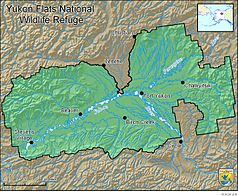Yukon Flats National Wildlife Refuge
| Yukon Flats National Wildlife Refuge | ||
|---|---|---|
| Meandering river in the Yukon Flats | ||
|
|
||
| Location: | Alaska , United States | |
| Next city: | Fort Yukon | |
| Surface: | 34,945 km² | |
| Founding: | 2nd December 1980 | |
The Yukon Flats National Wildlife Refuge is 34,945 km² and is the third largest protected area in the United States' National Wildlife Refuge System . It is located in the eastern interior of Alaska at the mouth of the Porcupine River in the Yukon . The refuge is bordered by the Brooks range to the north and the White Mountains to the south . The Arctic National Wildlife Refuge is directly connected to the northeast .
The Yukon Flats are a wetland in a basin on permafrost with lakes, rivers and mixed forests with spruce, birch and aspens, in the subarctic continental climate prevails. In winter, temperatures as low as −57 ° C can be reached and in summer, up to 38 ° C, the highest temperatures in comparable latitudes in North America.
history
Before the arrival of the first Europeans who were Yukon Flats hunting and fishing area athapaskischer natives . The large populations of fur animals attracted the first European-born hunters to the Yukon in the 19th century. The Hudson's Bay Company founded a trading post in Fort Yukon in 1847 within the boundaries of what would later become a protected area, but had to withdraw to Canadian soil in 1867 after the Alaska Purchase and was replaced by the Alaska Commercial Company .

In 1893 gold was found at Birch Creek , a tributary of the Yukon from the White Mountains. Circle , a settlement southeast of the later Wildlife Refuge , temporarily grew to a population of over 1000. In the 1920s, Fort Yukon was Alaska's main fur trading center.
In the late 1950s, plans arose to build a hydropower plant that would have completely flooded the Yukon Flats . Resistance from environmental organizations, indigenous associations and the United States Fish and Wildlife Service prevented the project.
On December 1, 1978, US President Jimmy Carter designated the Yukon Flats , along with 16 other protected areas in Alaska, as a National Monument based on the Antiquities Act of 1906 . As part of the Alaska National Interest Lands Conservation Act of December 2, 1980, the area boundaries were changed after political criticism and the status was downgraded to that of a wildlife refuge . The protected area is managed by the World Conservation Union in category IV ( biotope and species protection area ).
Wildlife
The sanctuary is home to Alaska's largest population of ducks and one of the largest aquatic bird breeding areas in North America. Most of the birds that breed here are migratory, but 13 species such as the Hudson's tit , the great gray owl and the spruce woodpecker stay in the region all year round.
Lynx , muskrats , mink and martens populate the river plains. Grizzly bears , wolves, and elk can be found throughout the sanctuary, while black bears prefer the forested lowlands. Dall sheep live in the tundra areas of the highlands.
Web links
- US Fish & Wildlife Service: Yukon Flats National Wildlife Refuge (official site; English)


